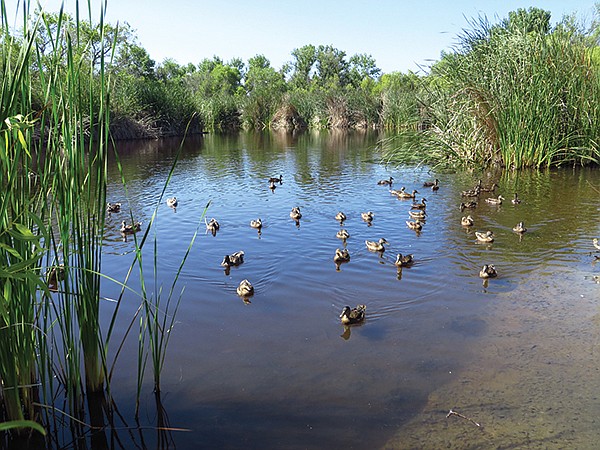 Facebook
Facebook
 X
X
 Instagram
Instagram
 TikTok
TikTok
 Youtube
Youtube

Any time of year, a visit to Mast Park and Mast Park West is an easy stroll under trees and by the waterways. The trails follow the San Diego River through the community of Santee and alongside the golf course. The San Diego River Park has benches, a native plant garden, spots to look out on the river, signs telling about the river ecosystem, and enough open space to forget about busy city life.

There are many bird species to observe. It is home to the endangered least Bell’s vireo and the California gnatcatcher as well as the southwest willow flycatcher, the great blue heron, the great egret, Cooper’s hawk, red-shouldered hawk, golden eagle, peregrine falcon, mallard and mandarin ducks, American coots, the acorn and Nuttall’s woodpeckers, the belted kingfisher, and black phoebe. Anna’s hummingbird can be observed year-round. During the spring and summer, numerous species stop off here. Examples include the Bullock’s oriole, lazuli bunting, black-chinned hummingbird, and the cliff swallow. Watch out for other animals, too, like the western pond turtle, the two-striped garter snake, western fence lizard, and butterflies including the tiger swallowtail, mourning cloak, and monarch.

Loop trails for both Mast Park and Mast Park West begin at the welcome sign off the parking lot. Facing the sign, there is a road off to your right that descends to another lot where the walk to Mast Park West begins by going under the Carlton Hills Blvd. bridge. The Mast Park West trail also begins on the other side of Carlton Hills Blvd., at a kiosk and small picnic area near a small shopping center. From both entrances, the trail follows the river west and then runs alongside a golf course. Along here the trail becomes the San Diego River Trail and winds around near SR 52. This is a longer walk than Mast Park.
Beginning at the same welcome sign, the Mast Park trails are off to the left. A portion of the trail is concrete and blacktop surfaces, but another portion of the trail leads down to the river where there is a bridge to walk over. This same portion of the trail can be entered from the nearby Walmart parking lot. Around here, plenty of dog-walkers are out and equestrians like to ride along the river.
Although invasive and nonnative plants grow here, there are ongoing efforts to restore native habitat areas. Cattails and bulrushes filter the river. Among sycamores, willows, and cottonwoods, mulefat and yerba mansa grow. Toyon and blue elderberry grow by the trail as well as Jimson weed or datura, coyote melon, wild grape, and wild cucumber.


Any time of year, a visit to Mast Park and Mast Park West is an easy stroll under trees and by the waterways. The trails follow the San Diego River through the community of Santee and alongside the golf course. The San Diego River Park has benches, a native plant garden, spots to look out on the river, signs telling about the river ecosystem, and enough open space to forget about busy city life.

There are many bird species to observe. It is home to the endangered least Bell’s vireo and the California gnatcatcher as well as the southwest willow flycatcher, the great blue heron, the great egret, Cooper’s hawk, red-shouldered hawk, golden eagle, peregrine falcon, mallard and mandarin ducks, American coots, the acorn and Nuttall’s woodpeckers, the belted kingfisher, and black phoebe. Anna’s hummingbird can be observed year-round. During the spring and summer, numerous species stop off here. Examples include the Bullock’s oriole, lazuli bunting, black-chinned hummingbird, and the cliff swallow. Watch out for other animals, too, like the western pond turtle, the two-striped garter snake, western fence lizard, and butterflies including the tiger swallowtail, mourning cloak, and monarch.

Loop trails for both Mast Park and Mast Park West begin at the welcome sign off the parking lot. Facing the sign, there is a road off to your right that descends to another lot where the walk to Mast Park West begins by going under the Carlton Hills Blvd. bridge. The Mast Park West trail also begins on the other side of Carlton Hills Blvd., at a kiosk and small picnic area near a small shopping center. From both entrances, the trail follows the river west and then runs alongside a golf course. Along here the trail becomes the San Diego River Trail and winds around near SR 52. This is a longer walk than Mast Park.
Beginning at the same welcome sign, the Mast Park trails are off to the left. A portion of the trail is concrete and blacktop surfaces, but another portion of the trail leads down to the river where there is a bridge to walk over. This same portion of the trail can be entered from the nearby Walmart parking lot. Around here, plenty of dog-walkers are out and equestrians like to ride along the river.
Although invasive and nonnative plants grow here, there are ongoing efforts to restore native habitat areas. Cattails and bulrushes filter the river. Among sycamores, willows, and cottonwoods, mulefat and yerba mansa grow. Toyon and blue elderberry grow by the trail as well as Jimson weed or datura, coyote melon, wild grape, and wild cucumber.